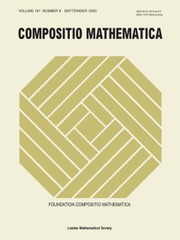Article contents
Higher symmetries of powers of the Laplacian and rings of differential operators
Published online by Cambridge University Press: 08 March 2017
Abstract
We study the interplay between the minimal representations of the orthogonal Lie algebra  $\mathfrak{g}=\mathfrak{so}(n+2,\mathbb{C})$ and the algebra of symmetries
$\mathfrak{g}=\mathfrak{so}(n+2,\mathbb{C})$ and the algebra of symmetries  $\mathscr{S}(\Box ^{r})$ of powers of the Laplacian
$\mathscr{S}(\Box ^{r})$ of powers of the Laplacian  $\Box$ on
$\Box$ on  $\mathbb{C}^{n}$ . The connection is made through the construction of a highest-weight representation of
$\mathbb{C}^{n}$ . The connection is made through the construction of a highest-weight representation of  $\mathfrak{g}$ via the ring of differential operators
$\mathfrak{g}$ via the ring of differential operators  ${\mathcal{D}}(X)$ on the singular scheme
${\mathcal{D}}(X)$ on the singular scheme  $X=(\mathtt{F}^{r}=0)\subset \mathbb{C}^{n}$ , for
$X=(\mathtt{F}^{r}=0)\subset \mathbb{C}^{n}$ , for  $\mathtt{F}=\sum _{j=1}^{n}X_{i}^{2}\in \mathbb{C}[X_{1},\ldots ,X_{n}]$ . In particular, we prove that
$\mathtt{F}=\sum _{j=1}^{n}X_{i}^{2}\in \mathbb{C}[X_{1},\ldots ,X_{n}]$ . In particular, we prove that  $U(\mathfrak{g})/K_{r}\cong \mathscr{S}(\Box ^{r})\cong {\mathcal{D}}(X)$ for a certain primitive ideal
$U(\mathfrak{g})/K_{r}\cong \mathscr{S}(\Box ^{r})\cong {\mathcal{D}}(X)$ for a certain primitive ideal  $K_{r}$ . Interestingly, if (and only if)
$K_{r}$ . Interestingly, if (and only if)  $n$ is even with
$n$ is even with  $r\geqslant n/2$ , then both
$r\geqslant n/2$ , then both  $\mathscr{S}(\Box ^{r})$ and its natural module
$\mathscr{S}(\Box ^{r})$ and its natural module  ${\mathcal{A}}=\mathbb{C}[\unicode[STIX]{x2202}/\unicode[STIX]{x2202}X_{n},\ldots ,\unicode[STIX]{x2202}/\unicode[STIX]{x2202}X_{n}]/(\Box ^{r})$ have a finite-dimensional factor. The same holds for the
${\mathcal{A}}=\mathbb{C}[\unicode[STIX]{x2202}/\unicode[STIX]{x2202}X_{n},\ldots ,\unicode[STIX]{x2202}/\unicode[STIX]{x2202}X_{n}]/(\Box ^{r})$ have a finite-dimensional factor. The same holds for the  ${\mathcal{D}}(X)$ -module
${\mathcal{D}}(X)$ -module  ${\mathcal{O}}(X)$ . We also study higher-dimensional analogues
${\mathcal{O}}(X)$ . We also study higher-dimensional analogues  $M_{r}=\{x\in A:\Box ^{r}(x)=0\}$ of the module of harmonic elements in
$M_{r}=\{x\in A:\Box ^{r}(x)=0\}$ of the module of harmonic elements in  $A=\mathbb{C}[X_{1},\ldots ,X_{n}]$ and of the space of ‘harmonic densities’. In both cases we obtain a minimal
$A=\mathbb{C}[X_{1},\ldots ,X_{n}]$ and of the space of ‘harmonic densities’. In both cases we obtain a minimal  $\mathfrak{g}$ -representation that is closely related to the
$\mathfrak{g}$ -representation that is closely related to the  $\mathfrak{g}$ -modules
$\mathfrak{g}$ -modules  ${\mathcal{O}}(X)$ and
${\mathcal{O}}(X)$ and  ${\mathcal{A}}$ . Essentially all these results have real analogues, with the Laplacian replaced by the d’Alembertian
${\mathcal{A}}$ . Essentially all these results have real analogues, with the Laplacian replaced by the d’Alembertian  $\Box _{p}$ on the pseudo-Euclidean space
$\Box _{p}$ on the pseudo-Euclidean space  $\mathbb{R}^{p,q}$ and with
$\mathbb{R}^{p,q}$ and with  $\mathfrak{g}$ replaced by the real Lie algebra
$\mathfrak{g}$ replaced by the real Lie algebra  $\mathfrak{so}(p+1,q+1)$ .
$\mathfrak{so}(p+1,q+1)$ .
Keywords
Information
- Type
- Research Article
- Information
- Copyright
- © The Authors 2017
References
- 3
- Cited by

